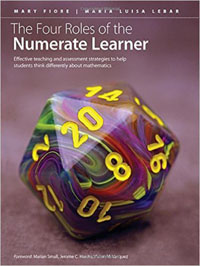| ________________
CM . . .
. Volume XXII Number 41. . . .June 22, 2016

 |
The Four Roles of the Numerate Learner: Effective Teaching and Assessment Strategies to Help Students Think Differently About Mathematics.
Mary Fiore & Maria Luisa Lebar.
Markham, ON: Pembroke Publishing, 2016.
96 pp., trade pbk. & pdf, $24.95 (pbk.), $21.95 (pdf).
ISBN 978-1-55138-311-8 (pbk.), ISBN 978-1-55138-915-8 (pdf).
Subject Headings:
Mathematics-Study and teaching (Elementary)-Evaluation.
Mathematics-Study and teaching (Early childhood)-Evaluation.
Effective teaching.
Professional.
Review by Thomas Falkenberg.
**** /4
|
| |
|

excerpt:
Unless we fully understand the complex roles of the numerate learner, we will be unable to create or foster an environment where students can make sense of mathematics, apply it to everyday contexts, and use it to question numbers, patterns, measurement, graphs, shapes, figures, pictures, and/or statistics in their world. Our goal in using this framework is to engage students to not only think critically about mathematics, but to act on this knowledge to transform a situation. (p. 22)
Our vision of mathematics teaching for the twenty-first century extends beyond the numerate learner to include the critical numerate learner. A critically numerate learner recognizes that mathematics used in practical situations has the potential to be politically and morally loaded. (pp. 9-10)
The Four Roles of the Numerate Learner is a professional book for school teachers. It is about teaching rather than a resource for teaching. The authors describe the book’s intended audience and professional development purpose as follows:
This book is designed for educators, school administrators, and those with the responsibility for leading change. It will serve as a guide for planning and implementing improvements in the teaching and learning of mathematics. It is also intended to engage educators in rich conversations about effective mathematics practices. (p. 11)
The first chapter outlines the assumptions and the conceptual framework for the approach to school mathematics education developed in the book. The authors make two assumptions upon which their approach to mathematics teaching rests: that the twenty-first century requires a more complex understanding of the literate student, and that there is to be an alignment of our understanding of the numerate student with this more complex understanding of being literate. In Chapter 1, the authors outline “the four roles of the literate learner framework” (p. 19) which are the meaning maker, the code user, the text user, and the text analyzer. This literacy framework translates into “the four roles of the numerate learner framework” (pp. 20-21), whereby these four roles are: the sense maker, the skill user, the thought communicator, the critical interpreter. Chapters 2-5 describe, in turn, these four roles in detail. In the brief chapter 6, the last chapter of the book, the authors review and elaborate further on the rationale for the framework: “The focus is on thinking differently about the way we view the curriculum content and doing things differently to support the development of skills necessary to function in today’s world” (p. 80).
The rich understanding of what it means to be numerate that the authors conceptualize can be found elsewhere in the school mathematics education literature, and the authors draw on some of those sources, particularly on the work by Marilyn Small, a well-known Canadian mathematics education scholar. On the other hand, there are many mainstream school mathematics education publications for teachers that are not as explicit about (or even exclude) “the critical interpreter” role of the numerate student. The authors characterize the critical interpreter as someone who “asks question that challenge attitudes, beliefs, biases, and perspectives that may lie beneath the surface of mathematical ideas, information represented in graphs and tables, usage of numbers, patterns, measurements, shapes figures, pictures, and/or statistics” (p. 23). This role of the numerate students aligns very well with the objective of critical thinking in other subject areas, like social studies, and language arts. The authors are to be applauded for being so explicit not just about what mathematics education can, but what mathematics education should contribute to citizenship education in schooling in Canada. In chapter 5, which is focused on the critical interpreter role of the numerate learner, the authors explore the meaning of this role further, link it to the notion of critical literacy, and provide a number of illustrative examples of what teaching for critical interpretation could look like.
The Four Roles of the Numerate Learner provides a solid conceptual framework for understanding what it means to be numerate – or, as others have coined it, to be mathematically literate. The authors integrated assessment strategies into the different chapters, and, by so doing, reflect the widespread understanding that assessment is an integral part of good teaching. The length of the book – less than a hundred pages – leaves room for just a few examples of the ideas and concepts explored in the book; but considering that the book is intended as a teacher professional development resource and that the book makes ample reference to additional readings on the respective topic or issue, the cost-content ratio is clearly in favour of the resource. The book is well structured with useful illustrative examples of the ideas and concepts, and provides indeed a very valuable professional development resource for teaching mathematics for the “numerate learner”.
Highly Recommended.
Thomas Falkenberg is a professor in the Faculty of Education at the University of Manitoba and teaches mathematics education courses in the faculty’s initial teacher education program.

To comment
on this title or this review, send mail to cm@umanitoba.ca.
Copyright © the Manitoba Library Association. Reproduction for personal
use is permitted only if this copyright notice is maintained. Any
other reproduction is prohibited without permission.
Next Review | Table of Contents For This Issue - June 22, 2016
CM Home | Back Issues
| Search
| CM Archive
| Profiles Archive
|
